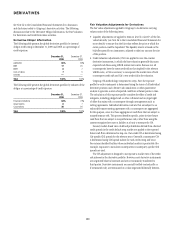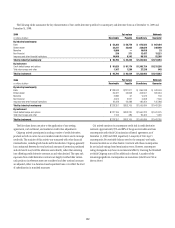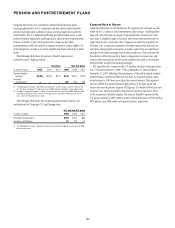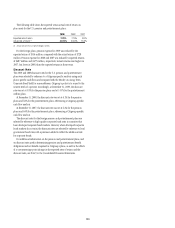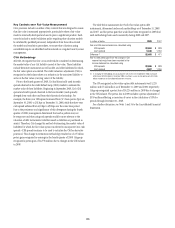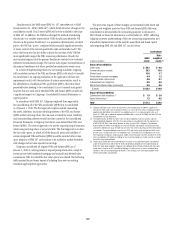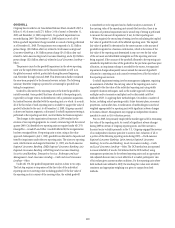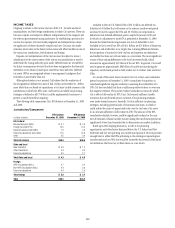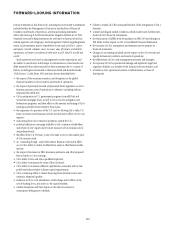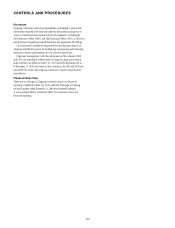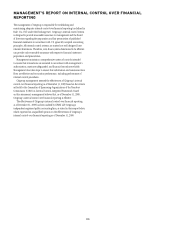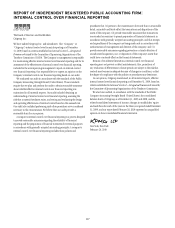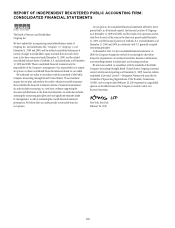Citibank 2009 Annual Report Download - page 119
Download and view the complete annual report
Please find page 119 of the 2009 Citibank annual report below. You can navigate through the pages in the report by either clicking on the pages listed below, or by using the keyword search tool below to find specific information within the annual report.
109
The preceding table reflects (i) the estimated portion of the assets of
former QSPEs to which Citigroup, acting as principal, had transferred
assets and received sales treatment as of December 31, 2009 (totaling
approximately $712.0 billion), and (ii) the estimated assets of significant
unconsolidated VIEs as of December 31, 2009 with which Citigroup is
involved (totaling approximately $219.2 billion) that are required to be
consolidated under the new accounting standards. Due to the variety of
transaction structures and the level of Citigroup involvement in individual
former QSPEs and VIEs, only a portion of the former QSPEs and VIEs with
which Citi is involved are to be consolidated.
In addition, the cumulative effect of adopting these new accounting
standards as of January 1, 2010, based on financial information as of
December 31, 2009, would result in an estimated aggregate after-tax charge
to Retained earnings of approximately $8.3 billion, reflecting the net effect
of an overall pretax charge to Retained earnings (primarily relating to the
establishment of loan loss reserves and the reversal of residual interests held)
of approximately $13.4 billion and the recognition of related deferred tax
assets amounting to approximately $5.1 billion.
The pro forma impact on certain of Citigroup’s regulatory capital
ratios of adopting these new accounting standards (based on financial
information as of December 31, 2009), reflecting immediate implementation
of the recently issued final risk-based capital rules regarding SFAS 166 and
SFAS 167, would be as follows:
As of December 31, 2009
As reported Pro forma Impact
Tier 1 Capital 11.67% 10.26% (141) bps
Total Capital 15.25% 13.82% (143) bps
The actual impact of adopting the new accounting standards on January
1, 2010 could differ, as financial information changes from the December 31,
2009 estimates and as several uncertainties in the application of these new
standards are resolved.
Among these uncertainties, the FASB has proposed an indefinite deferral
of the requirements of SFAS 167 for certain investment companies. Without
the proposed deferral, Citi had most recently estimated that approximately
$3.3 billion of assets held by investment funds managed by Citigroup would
be newly consolidated upon the adoption of SFAS 167. If the proposed deferral
were to be finalized as currently contemplated, Citi expects that many, if not
all, of the investment vehicles managed by Citigroup would not be subject
to the requirements of SFAS 167. Nevertheless, Citigroup is continuing to
evaluate the potential impacts of the proposed requirements and, depending
upon the eventual resolution of specific implementation matters, may be
required to consolidate certain investment vehicles, the aggregate assets of
which could range up to a total of approximately $1.2 billion. The effect
on Citi’s regulatory capital ratios, should consolidation of any or all such
noted investment vehicles be required, is not expected to be significant.
The preceding tables reflect Citi’s view that none of the investment vehicles
managed by Citigroup will be required to be consolidated under SFAS 167.
Proposed Changes to FDIC “Safe Harbor” Securitization
Rule
As described above, FASB’s issuance of SFAS Nos. 166 and 167, effective
starting in the first quarter of 2010, will result in the loss of GAAP sale
treatment in certain credit card and other securitization transactions and
the consolidation of the assets of such transactions into the assets of the
sponsoring entity. This development has raised concerns regarding effects
under the FDIC’s current “safe harbor” securitization rule. Under the current
rule, if a securitization is accounted for as a sale for GAAP purposes and
certain other conditions are satisfied, the FDIC, as conservator or receiver
of an insolvent bank, will treat the transferred assets as sold and surrender
any right to reclaim the assets transferred in the securitization. If securitized
assets are at risk of seizure by the FDIC in cases of conservatorship or
receivership, the credit treatment of the securitized transactions would be
impacted by the credit status of the sponsoring bank; for example, the highest
credit rating for a securitization transaction may be limited by the credit
rating of the sponsoring bank.
On November 12, 2009, the FDIC amended its securitization rule on an
interim basis so that it will continue to apply to assets transferred in securities
transactions completed on or prior to March 31, 2010 if the transfers would
have satisfied the conditions for GAAP sale treatment in effect for reporting
periods prior to November 15, 2009. The FDIC is currently engaged in
a rulemaking process regarding this issue, and the ultimate outcome is
unknown. If Citi is unwilling or unable to meet the conditions of any final
rule, the highest credit rating of securities issued in its credit card and certain
other securitization transactions may be limited to its then-current rating,
and Citi may engage in a reduced level of such transactions.



